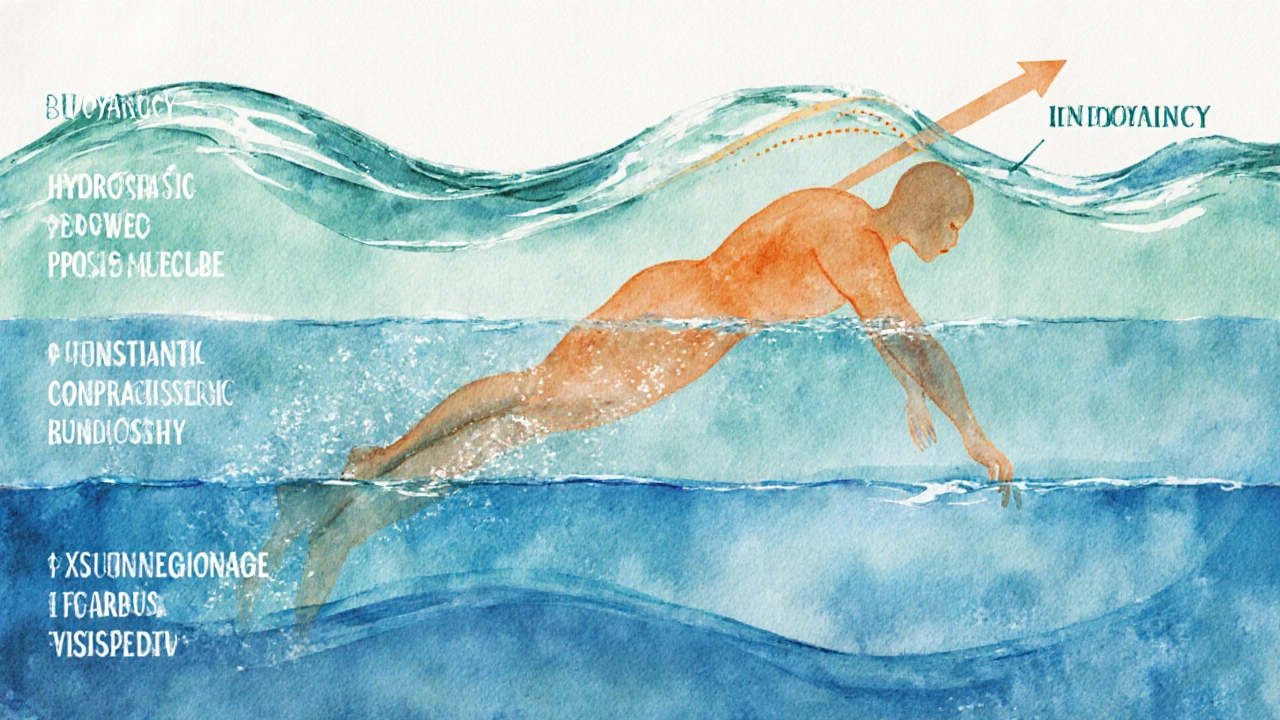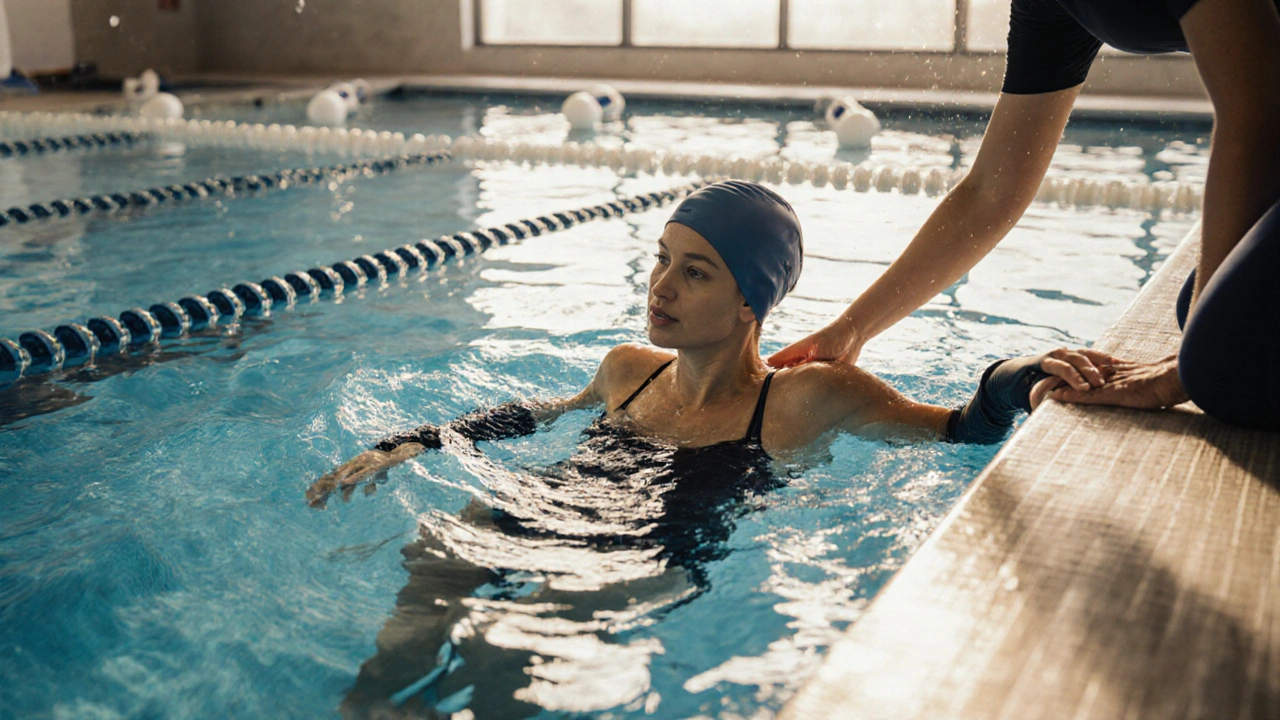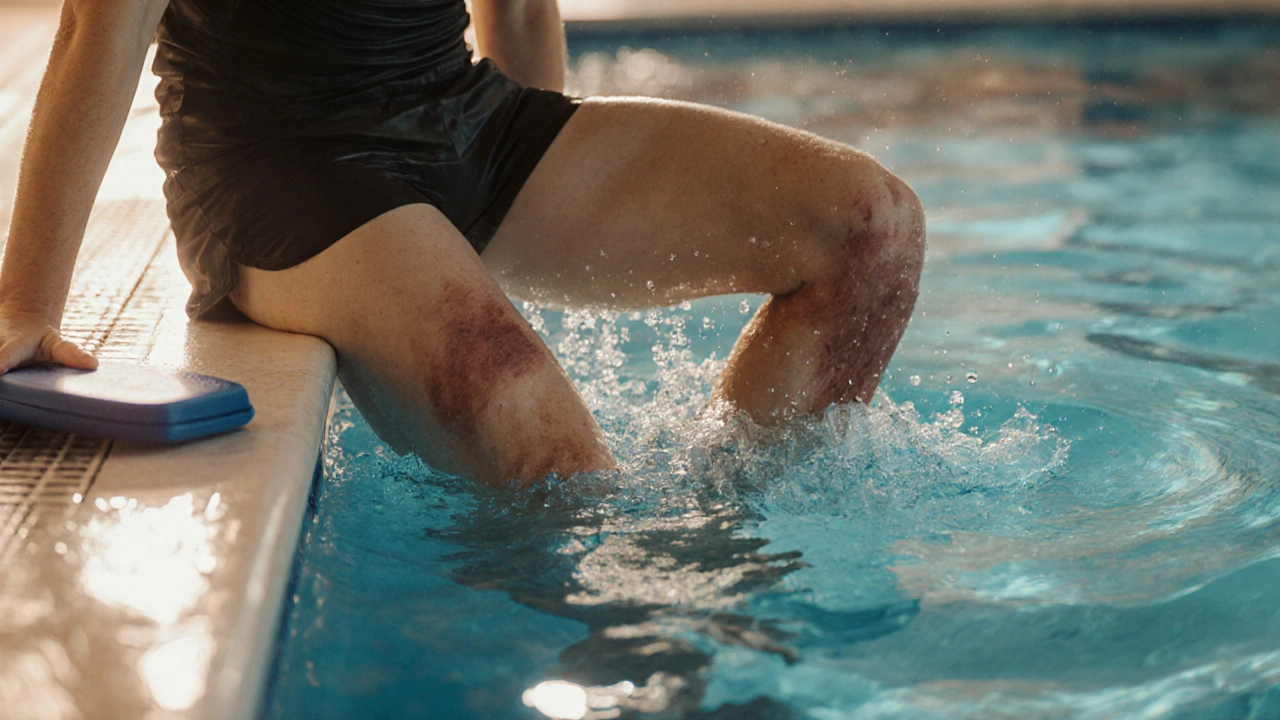Swimming Rehabilitation Progress Calculator
Progress Through Your Swimming Recovery
Answer these questions to determine your appropriate swimming rehabilitation phase and exercise recommendations based on your injury grade and pain levels.
When a muscle tears unexpectedly, the pain and downtime can feel overwhelming. Yet, Swimming is a low‑impact, full‑body activity that can speed up healing while keeping you moving. In this guide we unpack how swimming benefits for muscle injuries work, what to watch out for, and how to fit water‑based rehab into a real‑world recovery plan.
Key Takeaways
- Swimming reduces inflammation and swelling through hydrostatic pressure.
- The buoyancy of water lets you move a damaged muscle without painful loading.
- Controlled resistance improves blood flow, delivering nutrients that accelerate muscle recovery.
- Typical protocols start with gentle kicking drills and progress to full strokes within 2‑4 weeks.
- Contra‑indications include open wounds, severe joint instability, and uncontrolled bleeding.
Understanding Acute Skeletal Muscle Injuries
Acute skeletal muscle injury is a sudden rupture or strain of muscle fibers, often caused by overload, awkward movement, or direct impact. These injuries fall into three grades:
- Grade I - microscopic tears, mild soreness, and minimal loss of strength.
- Grade II - partial tears, noticeable swelling, and reduced range of motion.
- Grade III - complete rupture, severe pain, and a clear functional deficit.
Inflammation spikes within the first 48‑72 hours, bringing pain, heat, and edema. The body’s repair phase then shifts toward fibroblast activity and collagen deposition, which can take weeks to months. Early, appropriate movement is key to preventing scar tissue that limits future flexibility.

Why Water? The Science Behind Hydrotherapy
Swimming is a form of hydrotherapy, a therapeutic use of water that leverages several physical properties:
- Buoyancy reduces the effective weight of the body by up to 90%, allowing injured muscles to move with far less joint stress.
- Hydrostatic pressure gently compresses tissues, improving venous return and limiting swelling.
- Thermal conductivity (when water is warm) relaxes tight fibers and increases metabolic rates, speeding up nutrient delivery.
- Viscous resistance offers a natural, adjustable load that promotes gentle strengthening without heavy weights.
These effects collectively lower inflammation, sustain cardiovascular fitness, and preserve range of motion while the muscle rebuilds.
How Swimming Accelerates Muscle Recovery
During swimming, each stroke generates a rhythmic contraction‑relaxation cycle that mimics the muscle’s natural movement patterns. This has three direct benefits:
- Enhanced blood flow: The combination of warm water and gentle muscle activity increases perfusion by 30‑40%, delivering oxygen and amino acids required for tissue repair.
- Controlled loading: The resistance of moving through water provides a low‑impact strength stimulus that encourages collagen alignment along functional lines, reducing the risk of re‑injury.
- Neuromuscular re‑education: Repeating stroke patterns retrains motor units, helping the injured muscle regain coordinated firing sooner.
Studies from sports medicine clinics in 2023‑2024 show that athletes who added 20‑30 minutes of moderate‑intensity swimming to standard physiotherapy recovered functional strength 12‑18% faster than those who only performed land‑based exercises.
Practical Guidelines: Getting Started with Swimming Rehab
Before you jump in, talk to a physiotherapist to confirm that swimming is safe for your specific grade of injury. Once cleared, follow a phased approach:
- Phase 1 - 48‑72hours post‑injury: Focus on passive immersion and gentle ankle/hip pumps to aid circulation. No active kicking yet.
- Phase 2 - Days 3‑7: Introduce shallow water walking or stationary kicking while holding the pool edge. Aim for 5‑10 minutes, keeping intensity at a “light” level (RPE 2‑3/10).
- Phase 3 - Days 8‑14: Progress to flutter kicks with a kickboard, adding brief intervals of front‑crawl arm pulls. Monitor pain; stop if it exceeds a mild ache.
- Phase 4 - Weeks 2‑4: Incorporate full strokes (breaststroke, backstroke) at a comfortable pace. Add interval training: 30seconds moderate effort, 30seconds rest, repeat 6‑8 times.
- Phase 5 - Weeks 4‑6+: Increase duration to 30‑45minutes, introduce resistance tools like aqua gloves or paddles, and begin light land‑based strengthening to transition back to sport‑specific drills.
Key tips to maximise benefit:
- Maintain water temperature between 30‑32°C (86‑90°F) for optimal muscle relaxation.
- Start each session with a brief warm‑up (5minutes of gentle moving) and end with static stretching.
- Track pain on a simple 0‑10 scale; a rise above 3 warrants a session reduction.
- Stay hydrated - even in water, dehydration can impair recovery.

Safety, Contra‑indications, and Common Pitfalls
Although swimming is gentle, it isn’t risk‑free. Avoid water‑based rehab if you have:
- Open wounds or surgical incisions that could become infected.
- Severe joint instability that might be aggravated by uneven pool surfaces.
- Uncontrolled bleeding or blood‑clotting disorders.
Typical mistakes include:
- Doing high‑intensity sprints too early - this spikes inflammation.
- Skipping the warm‑up - cold water can cause muscle spasm.
- Using overly cool water - reduces the vasodilation effect and may increase stiffness.
Swimming vs. Land‑Based Rehabilitation: A Quick Comparison
| Aspect | Swimming (Hydrotherapy) | Land‑Based Rehab |
|---|---|---|
| Impact on Injured Tissue | Low - buoyancy supports up to 90% body weight | Variable - often weight‑bearing unless using machines |
| Inflammation Control | Hydrostatic pressure reduces swelling | Rely on manual techniques & ice |
| Cardiovascular Load | Maintains aerobic fitness safely | May need separate cardio sessions |
| Range of Motion | Improved via unrestricted limb movement | Often limited by pain or joint stress |
| Equipment Needs | Pool access, optional kickboard | Gym machines, resistance bands |
| Progression Speed | Typically 12‑18% faster functional gains | Standard progression timelines |
Both approaches can be combined for optimal outcomes-use swimming to keep the muscle moving early, then integrate land‑based strength work once pain subsides.
Frequently Asked Questions
Can I swim if I have a Grade II muscle tear?
Yes, provided the pool water is warm and you limit activity to gentle kicking and short intervals. Aim for 5‑10minutes initially and increase only if pain stays low.
How soon after injury should I start swimming?
Most clinicians recommend starting passive immersion within 48hours. Active kicking usually begins after the first 72hours, once swelling has eased.
Do I need a special pool for rehab?
A standard indoor pool with controllable temperature (30‑32°C) works fine. Depth of 1‑1.2m lets you stand for leg drills while keeping the torso supported.
Will swimming replace physiotherapy?
Swimming complements physiotherapy but doesn’t replace hands‑on manual therapy, targeted stretching, or progressive strength training prescribed by a therapist.
What if I feel a sharp pain during a stroke?
Stop immediately. Sharp or shooting pain often signals overload. Consult your therapist before resuming, and consider reducing intensity or switching to a gentler kickboard exercise.
Swimming offers a unique blend of gentle loading, inflammation control, and cardiovascular maintenance that makes it a standout tool for managing acute skeletal muscle injuries. By following a graded protocol, respecting contraindications, and pairing water work with targeted land‑based exercises, you can shorten downtime and return to full strength more confidently.


Comments (6)
Jennifer Wees-Schkade
October 13, 2025 AT 13:56Swimming is a low‑impact way to get blood flowing to damaged muscles without over‑loading the joints. The buoyancy reduces compression, so you can move through a wider range of motion while keeping strain minimal. Hydrostatic pressure helps limit swelling and speeds up the removal of metabolic waste. For Grade I and II tears, gentle laps with a kickboard can promote collagen alignment during the remodeling phase. Just keep the intensity low and listen to pain signals – stop the moment you feel sharp discomfort.
Fr. Chuck Bradley
October 24, 2025 AT 09:06The pool becomes a stage where my injured muscles perform a silent ballet, each ripple echoing the ache of yesterday. I watch the water swallow my doubts, yet I remain a quiet spectator, letting the currents carry my hopes without demanding any applause. The recovery feels like a moonlit tide, beautiful yet untouchable.
Patrick Rauls
November 4, 2025 AT 04:16Yo, if you’re stuck with a sore hamstring, just hop in the pool and start doing some easy flutter kicks – it’s super easy and you’ll feel it loosening up fast :) Remember to keep your head above water and breathe deep, that’s key to loosening up those tight fibers. Don’t push too hard, let the water do the work for ya!
Asia Lindsay
November 14, 2025 AT 23:26💪 Totally agree! Start with short intervals, like 2‑minute swims, then add 30‑second rests. Keep a log of how you feel after each set – that way you can track progress and stay motivated. If you ever feel a twinge, dial it back and focus on smooth strokes. Consistency beats intensity any day! 🚀
Angela Marie Hessenius
November 25, 2025 AT 18:36Swimming has been celebrated across civilizations for its therapeutic virtues, from ancient Roman baths to modern rehabilitation centers. In many cultures the act of moving through water is not merely exercise but a ritual of healing that engages both body and spirit. When an acute skeletal muscle injury occurs, the inflammatory cascade triggers swelling, pain, and a temporary loss of function. The hydrostatic pressure exerted by the surrounding water acts as a gentle compressive force, which can help to moderate the edema that often accompanies such injuries. Moreover, the buoyancy provided by water reduces the effective body weight by up to ninety percent, allowing the injured limb to move through a near‑weightless environment. This reduction in load permits the practitioner to perform range‑of‑motion exercises without the fear of re‑rupturing delicate muscle fibers. The viscosity of water also offers a natural resistance, encouraging gradual strengthening of the affected musculature as the patient progresses. As the patient moves, the laminar flow of water around the skin enhances microcirculation, delivering oxygen and nutrients to the damaged tissue while sweeping away metabolic by‑products. Such enhanced perfusion is known to accelerate the proliferative phase of muscle repair, facilitating the alignment of newly formed collagen fibers. From a neurological standpoint, the rhythmic buoyancy and cool temperature of the water can modulate pain perception by stimulating mechanoreceptors that compete with nociceptive signals. This phenomenon, often described as “gate control,” helps to lower the subjective experience of pain during early rehabilitation. In practical terms, a well‑structured swimming protocol typically begins with low‑intensity, non‑impact movements such as water walking or gentle freestyle strokes. As tolerance improves, the therapist may introduce interval training, focusing on short bursts of activity followed by rest, to progressively load the muscle without overtaxing it. It is essential to monitor pain levels using a simple 0‑to‑10 scale, ensuring that the intensity remains within a therapeutic window. Studies have shown that patients who adhere to aquatic therapy programs often regain functional capacity faster than those who rely solely on land‑based exercises. Ultimately, swimming offers a unique blend of mechanical unloading, circulatory enhancement, and neuromodulatory effects that together create an optimal environment for the recovery of acute skeletal muscle injuries.
shawn micheal
December 6, 2025 AT 13:46Feeling discouraged after a tear? Flip that mindset! The water is basically a supportive friend that lets you move without hurting yourself. Start with just a few laps and celebrate every tiny improvement – that’s how momentum builds. Before you know it, you’ll be back to your pre‑injury routine, stronger and more confident.